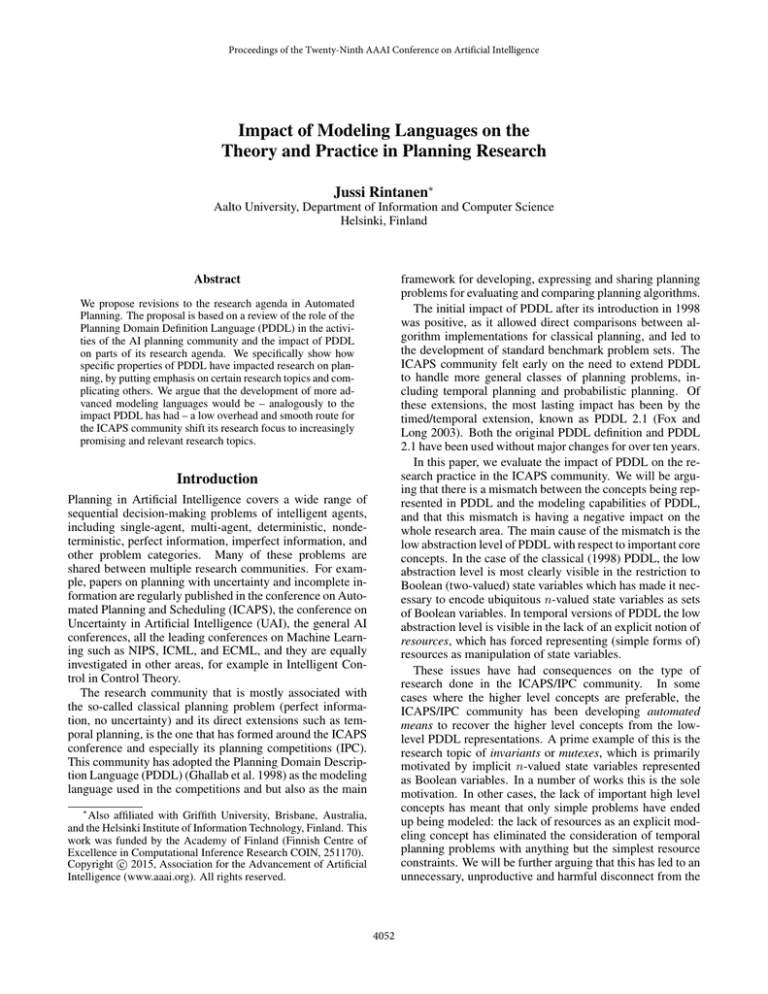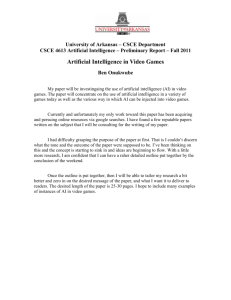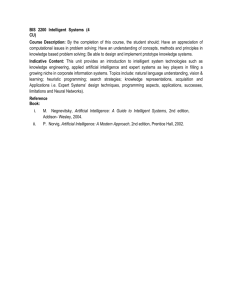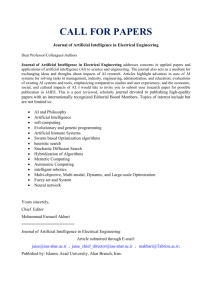
Proceedings of the Twenty-Ninth AAAI Conference on Artificial Intelligence
Impact of Modeling Languages on the
Theory and Practice in Planning Research
Jussi Rintanen∗
Aalto University, Department of Information and Computer Science
Helsinki, Finland
Abstract
framework for developing, expressing and sharing planning
problems for evaluating and comparing planning algorithms.
The initial impact of PDDL after its introduction in 1998
was positive, as it allowed direct comparisons between algorithm implementations for classical planning, and led to
the development of standard benchmark problem sets. The
ICAPS community felt early on the need to extend PDDL
to handle more general classes of planning problems, including temporal planning and probabilistic planning. Of
these extensions, the most lasting impact has been by the
timed/temporal extension, known as PDDL 2.1 (Fox and
Long 2003). Both the original PDDL definition and PDDL
2.1 have been used without major changes for over ten years.
In this paper, we evaluate the impact of PDDL on the research practice in the ICAPS community. We will be arguing that there is a mismatch between the concepts being represented in PDDL and the modeling capabilities of PDDL,
and that this mismatch is having a negative impact on the
whole research area. The main cause of the mismatch is the
low abstraction level of PDDL with respect to important core
concepts. In the case of the classical (1998) PDDL, the low
abstraction level is most clearly visible in the restriction to
Boolean (two-valued) state variables which has made it necessary to encode ubiquitous n-valued state variables as sets
of Boolean variables. In temporal versions of PDDL the low
abstraction level is visible in the lack of an explicit notion of
resources, which has forced representing (simple forms of)
resources as manipulation of state variables.
These issues have had consequences on the type of
research done in the ICAPS/IPC community. In some
cases where the higher level concepts are preferable, the
ICAPS/IPC community has been developing automated
means to recover the higher level concepts from the lowlevel PDDL representations. A prime example of this is the
research topic of invariants or mutexes, which is primarily
motivated by implicit n-valued state variables represented
as Boolean variables. In a number of works this is the sole
motivation. In other cases, the lack of important high level
concepts has meant that only simple problems have ended
up being modeled: the lack of resources as an explicit modeling concept has eliminated the consideration of temporal
planning problems with anything but the simplest resource
constraints. We will be further arguing that this has led to an
unnecessary, unproductive and harmful disconnect from the
We propose revisions to the research agenda in Automated
Planning. The proposal is based on a review of the role of the
Planning Domain Definition Language (PDDL) in the activities of the AI planning community and the impact of PDDL
on parts of its research agenda. We specifically show how
specific properties of PDDL have impacted research on planning, by putting emphasis on certain research topics and complicating others. We argue that the development of more advanced modeling languages would be – analogously to the
impact PDDL has had – a low overhead and smooth route for
the ICAPS community shift its research focus to increasingly
promising and relevant research topics.
Introduction
Planning in Artificial Intelligence covers a wide range of
sequential decision-making problems of intelligent agents,
including single-agent, multi-agent, deterministic, nondeterministic, perfect information, imperfect information, and
other problem categories. Many of these problems are
shared between multiple research communities. For example, papers on planning with uncertainty and incomplete information are regularly published in the conference on Automated Planning and Scheduling (ICAPS), the conference on
Uncertainty in Artificial Intelligence (UAI), the general AI
conferences, all the leading conferences on Machine Learning such as NIPS, ICML, and ECML, and they are equally
investigated in other areas, for example in Intelligent Control in Control Theory.
The research community that is mostly associated with
the so-called classical planning problem (perfect information, no uncertainty) and its direct extensions such as temporal planning, is the one that has formed around the ICAPS
conference and especially its planning competitions (IPC).
This community has adopted the Planning Domain Description Language (PDDL) (Ghallab et al. 1998) as the modeling
language used in the competitions and but also as the main
∗
Also affiliated with Griffith University, Brisbane, Australia,
and the Helsinki Institute of Information Technology, Finland. This
work was funded by the Academy of Finland (Finnish Centre of
Excellence in Computational Inference Research COIN, 251170).
c 2015, Association for the Advancement of Artificial
Copyright Intelligence (www.aaai.org). All rights reserved.
4052
– motivation behind invariant algorithms (Rintanen 1998;
Edelkamp and Helmert 2000; Gerevini and Schubert 2000;
Rintanen 2000; 2008; Helmert 2009; Bernardini and Smith
2011), and was similarly a main motivation for the planning
graph construction of Blum and Furst (1995). A vast majority of the examples used in these works are for recovering
many-valued variables representing e.g. locations (although
some of the algorithms – but by no means all – can also find
other types of invariants.)
Many-valued state variables are needed for constructing the so-called domain transition graphs (Jonsson and
Bäckström 1998) that are behind many methods for computing domain-independent heuristics for explicit state-space
search (Helmert 2004; Richter and Westphal 2010; Katz and
Domshlak 2010), and, as in the original papers, have often
been used also in more theoretical works. Many-valued state
variables are already de facto being used by most modern
planners: a standard preprocessing step is the automated extraction of a many-valued representation from Boolean state
variables. This step can be quite expensive1 , and – in the big
picture – it is completely unnecessary as the same information would at no cost be available in higher-level models.
The original PDDL definition included unbounded integers, but many of the standard benchmark problems still
represent finite-range integer variables as sets of Boolean
variables. For many search methods (basically, any other
than forward search / explicit state-space search) this poses
an unreasonable and completely unnecessary complication:
actions with e.g. increments of integer variables with range
[0, n] are represented as n actions, each with precondition
corresponding to some i ∈ {0, . . . , n − 1} and an effect
corresponding to i + 1. This split works perfectly fine with
forward search, but with e.g. backward search it forces the
planner to arbitrarily commit to one particular value of i
(when, as is often the case, the current set of subgoals does
not determine the value i + 1), rather than let the value be
determined at later stages of the search. This problem has a
dramatic performance penalty.
Similarly to invariants/mutexes for the automated detection of many-valued state variables, integer variables too
would seemingly inspire an artificial research problem of automatically recognizing integer-valued state variables from
Boolean representations to allow representing them more effectively.
The only reasonable way of resolving this unsatisfactory
situation, of course, is to move to modeling languages and
models where many-valued and bounded integer variables
are represented explicitly. Such a move would be technically minor: both many-valued (enumerated) and bounded
integer-valued variables can be directly and easily accommodated in all leading search methods used in planning and
state-space search in general. The consequences of such a
move would be, firstly, allowing far easier modeling of planning problems where reasoning about numeric values is crit-
by far most prominent types of planning&scheduling problems, namely standard pure scheduling problems with no
planning component, and that this connection could be one
of the most promising routes for planning research to have
more substantial real-world relevance.
The properties of the modeling language might seem like
a minor concern. However, a vast majority of all papers
on classical and temporal planning have their experimental part exclusively test their ideas with the IPC benchmark
problems and nothing else. For this reason the properties
of the benchmark problems, and the precise way the benchmark problems have been modeled, have had a profound impact on how these (quite substantial) parts of the ICAPS/IPC
community are conducting their research, and what they are
researching.
As an action for rectifying these problems, we propose
the adoption of more powerful modeling languages with
high level concepts that better match the actual modeling
requirements the community is already facing. Adoption
of more advanced languages may seem like a minor trajectory change, but we believe that this could fundamentally change the type of problems being addressed by the
ICAPS/IPC community, and would spur new type of research that would have more relevance from the applications perspective. The need for the ICAPS/IPC community
to fundamentally change is widely recognized, but concrete
proposals about how this could happen have not emerged.
Our paper is one attempt to impact one central part of the
ICAPS/IPC community’s activities, the benchmarking of
planning algorithms in connection with the competitions and
most of the research on classical and temporal planning.
The Original PDDL Definition from 1998
PDDL (Ghallab et al. 1998) was the first modeling language
widely used in the planning community for a wide range of
different types of planners. Its conception coincides with
the first planning competition in 1998. We will discuss two
topics in connection with the classical (non-temporal) part
of PDDL, the datatypes, and the measurement of quality of
a plan.
Boolean State Variables
Historically, early works on planning focused on Boolean
2-valued state variables, presumably because they are theoretically sufficient for expressing any finite state transition
system, and they are also in practice sufficient for representing quite complex problems.
The original PDDL definition includes state variables
with Boolean, integer and real values, but a very large proportion of all planners only implement Boolean variables,
and numeric variables do not appear in most of the commonly used benchmark problems.
However, many-valued state variables represented as sets
of Boolean variables are present in almost all IPC benchmark problems, and lots of planning techniques are based
on many-valued representations of these planning problems. Recovering the many-valued state variables from
the Boolean representation is the main – yet often unstated
1
The FD framework can spend several minutes extracting (or attempting to extract) a many-valued representation from a Boolean
PDDL representation, even with small problem instances with only
a couple of hundred state variables.
4053
ical, and, secondly, motivate the development of new search
technologies that take advantage of the richer, more structured problem representations.
pairwise overlapping of two actions can be prevented. More
general forms of resources include general n-ary resources,
which allow 1 or more actions to simultaneously use at most
n units of the resource (possibly also including non-integer
amounts of the resource), and state resources, which allow
multiple actions to use the same resource if they require the
resource to be in the same state. PDDL 2.1 has no direct
mechanisms for representing these types of resources, although their representation is possible.
What the PDDL 2.1 semantics easily allows, and for
which it seems to have been designed, is reduction of unary
resource allocation to state-variable manipulation: an action
allocates a resource implicitly related to Boolean state variable x by having x in its precondition and immediately falsifying x as its at start effect. Now two actions both depending on x cannot both be taken simultaneously, because
PDDL 2.1 disallows an action with precondition x if it is
made false by another action simultaneously. The implicit
resource is freed as an at end effect of an action. In most
of the IPC benchmark problems a resource associated with
some object is implicit in the set of state variables representing the state of the object, for example the location. An action moving an object requires that the object is in a certain
location, immediately falsifies the corresponding state variable, and makes another state variable, indicating a different
location, true as its at end effect.
Resources are, in fact, a central concept in many types of
(real world) planning and scheduling problems. Most forms
of scheduling problems arise only because of the resource
conflicts between their tasks or actions. (Temporal) planning
has been traditionally viewed as an extension of scheduling
where not only a schedule has to be found but also the tasks
– which are fixed in scheduling problems – have to be selected and sequenced. In this sense PDDL 2.1 represents a
radical departure from established ideas in the planning and
scheduling field, by not directly supporting the explicit expression of the scheduling aspect of planning.
Planning competitions have mostly focused on modifications of the classical benchmark problems, essentially with
only action durations added. Other benchmark problems focus on the concept of required concurrency (Cushing et al.
2007), which forces some actions to be concurrent. This
is a property that is almost completely absent from most
types of real-world scheduling problems, and hence it is not
clear how generally important required concurrency is, even
for planning. Focus on required concurrency was originally
motivated by the observation that most early temporal planning benchmark problems could be easily solved by classical planners. Of course, the main issue in much of realworld planning&scheduling is that the makespan (total use
of time) and resource use gets minimized, so the solution to
overly simplistic planners that solve temporal problems by
ignoring time is to take the minimization of makespan seriously as a quality measure for plans, not developing problems that require concurrency explicitly.
Quality Measures for Plans
Actions in PDDL can be associated with a cost, and the cost
of a plan can be defined as the sum of the costs of the actions
in the plan. This is a perfectly acceptable quality measure for
problems that are sequential, especially single-agent planning problems in which the agent is able to take one action
at a time. The per-action cost could be viewed as a monetary
cost or a cost in terms of time.
However, real-world planning problems with this cost criterion are rare. An inspection of the IPC benchmark problems also shows that almost all are actually inherently parallel: multiple agents/actors/vehicles/machines can take multiple actions in parallel and independently of each other. In
most of the real-world planning&scheduling problems the
time span in which a plan can be executed (makespan in
scheduling research) is an equally and often a more important factor in assessing the value of a plan.
So even though classical planning in its essence is about
asynchronous/untimed sequences of actions, even in the
standard benchmark sets almost all of the problems are actually instances of temporal planning with the time information stripped off. This raises the question, what is it that the
planning community wants to achieve with classical planning? Would it be more productive to openly recognize the
fact that almost all of the benchmark problems really are
about temporal planning, and draw the obvious conclusions?
PDDL 2.1 for Planning with Time
Fox and Long’s (2003) PDDL 2.1 extends the original definition with timed actions, continuous change, and a number of other features. This definition provides fixes to many
of the questions that arose with the classical PDDL definition regarding concurrency and quality measures that refer to
makespan: actions are associated with a duration and plans
are associated with schedules which express at which time
points actions are taken, allowing to determine makespans.
Although the language definition immediately faced criticism for most of its design decisions (Bacchus 2003;
Boddy 2003; Geffner 2003; McDermott 2003; Smith 2003),
the language still has been the de facto temporal planning
language of the ICAPS/IPC community because of its use in
the planning competitions.2 We will be discussing some of
its main properties in regard to planning research.
Resources
One of the main omissions in PDDL 2.1 – as pointed out
by e.g. Geffner (2003) – is the lack of direct support of resources. Resources are one of the most central concepts in
scheduling. The class of resources that can be most naturally
represented in PDDL 2.1 is unary resources, with which
2
However, few application-oriented works have adopted PDDL
2.1 as their modeling language. Research organizations such as
NASA have developed their own temporal planning languages,
such as ANML (Smith, Frank, and Cushing 2008).
Scalability Implications of Resources in PDDL 2.1
A main issue with implicit low-level representations of resources is the difficulty of reasoning about them. Infer-
4054
types found in scheduling problems, including n-ary resources and state resources. Implications of explicit notions
of resources are similar to the ones of advanced datatypes.
Additionally, addressing the tight connection between temporal planning and scheduling would immediately give the
planning community access to a rich collection of realistic large-scale models, with the possibility to enhance them
with aspects of planning.
ring that two actions cannot overlap cannot be checked
by looking at the two actions’ preconditions and effects
only. One needs to check whether the precondition of
the later action can become true after having been falsified by the first action, which is non-trivial inference involving the entire action set (Bernardini and Smith 2011;
Rintanen 2014).
Additionally, the low abstraction level also in this case
rules out efficient and the most natural implementations for
example with constraint-based search methods. Shin and
Davis (2005) presented a reduction from PDDL 2.1 to the
SAT modulo Theories (Audemard et al. 2002) framework.
A curious property of this reduction for almost all of the IPC
benchmark problems is that – due to PDDL 2.1 representation of implicit unary resources – two consecutive actions
that need the same (related) resource – for example two actions moving the same vehicle – necessarily have a non-zero
gap between them. This is caused by the way the allocation of implicit unary resources is encoded as at start effects
that falsify the action’s own preconditions. For SMT-based
representations of temporal planning this gap between actions typically means a factor of two increase in the number
of steps required in a plan, in comparison to what is possible with an explicit notion of resources, with which the
gap is avoided. This increase in the number of steps means
– similarly to Planning as SAT (Kautz and Selman 1996;
Rintanen, Heljanko, and Niemelä 2004) – an exponential increase in runtimes, and therefore poor scalability of many
natural constraint-based representations.
Actions
The obvious way forward is to adopt a new modeling language, covering both classical and temporal planning, without many of the unused features of current PDDL dialects,
and with stronger modeling support for important high-level
concepts such as resources and a richer set of datatypes. In
the 2014 planning competition close to half of the planners
were built on the Fast Downward framework, which is already using many-valued state variables internally. Dozens
of planners could be transitioned to a richer modeling language simply by re-implementing and extending parts of
FD. Accommodating the kind of extensions discussed in this
paper do not appear to involve interesting technical challenges at the implementation level. For example, implementations would still be free to reduce many-valued variables to
Booleans if it provides benefits at the implementation level.
Conclusion
We have argued that design decisions of existing modeling
languages used by the ICAPS/IPC community have affected
its research and other activities
Low abstraction level of a modeling language means that
low-level decisions – sometimes with a strong computational impact – are unnecessarily made at the time when
the model is designed. We have given examples of this for
PDDL: many-valued (enumerated) state variables and finiterange integer state variables modeled as sets of Boolean state
variables, as well as representation of resources as low-level
manipulation of state variables.
The low abstraction level in PDDL has inspired or necessitated the development of abstraction methods for recovering the relevant higher level concepts from PDDL models.
This has been most visible with many-valued state variables
which have been recognized with algorithms for finding invariants.
PDDL in its different incarnations is showing its age (over
16 years), it has no formal semantics, and has many limitations in terms of what kind of problems are expressible in it.
Replacing it with a modern modeling language with clean
semantics and syntax would quickly take the planning community several steps toward more important applications in
AI and elsewhere.
Modeling for Planning: Requirements
We discuss requirements that advanced modeling languages
for planning should fulfill.
Asynchronous Models
For classical (asynchronous) planning problems, a main requirement is the support of a wider range of data types.
Bounded integers and enumerated types are standard in
modeling languages in related research communities, for example in computer-aided verification. Much more realistic
problems could be promoted in the IPC if richer datatypes
were available and widely supported. Much of research on
classical planning has limited not only to Boolean state variables, but also to the simplest possible action model, with
(unconditional) assignments as effects, and conjunctions of
positive literals as preconditions.
A more advanced modeling language would support the
expression of problems that are structurally very different
from the current benchmark problems. This would spur new
research in all aspects of classical planning, and would help
the ICAPS/IPC community acquire and use system models
also from other research communities, and thereby demonstrate relevance also outside the IPC problems sets.
References
Audemard, G.; Bertoli, P.; Cimatti, A.; Korniłowicz, A.;
and Sebastiani, R. 2002. A SAT based approach for solving formulas over Boolean and linear mathematical propositions. In Voronkov, A., ed., Automated Deduction - CADE18, 18th International Conference on Automated Deduc-
Timed Models
The main issue in PDDL 2.1 we have addressed is resources.
A minimum requirement for an advanced language for temporal planning is a full support of the most basic resource
4055
Katz, M., and Domshlak, C. 2010. Implicit abstraction heuristics. Journal of Artificial Intelligence Research
39(1):51–126.
Kautz, H., and Selman, B. 1996. Pushing the envelope:
planning, propositional logic, and stochastic search. In Proceedings of the 13th National Conference on Artificial Intelligence and the 8th Innovative Applications of Artificial
Intelligence Conference, 1194–1201. AAAI Press.
McDermott, D. V. 2003. PDDL2.1 - the art of the possible? commentary on Fox and Long. Journal of Artificial
Intelligence Research 20:145–148.
Richter, S., and Westphal, M. 2010. The LAMA planner:
guiding cost-based anytime planning with landmarks. Journal of Artificial Intelligence Research 39:127–177.
Rintanen, J.; Heljanko, K.; and Niemelä, I. 2004. Parallel
encodings of classical planning as satisfiability. In Logics
in Artificial Intelligence: 9th European Conference, JELIA
2004, Lisbon, Portugal, September 27-30, 2004. Proceedings, number 3229 in Lecture Notes in Computer Science,
307–319. Springer-Verlag.
Rintanen, J. 1998. A planning algorithm not based on directional search. In Principles of Knowledge Representation
and Reasoning: Proceedings of the Sixth International Conference (KR ’98), 617–624. Morgan Kaufmann Publishers.
Rintanen, J. 2000. An iterative algorithm for synthesizing invariants. In Proceedings of the 17th National Conference on Artificial Intelligence (AAAI-2000) and the 12th
Conference on Innovative Applications of Artificial Intelligence (IAAI-2000), 806–811. AAAI Press.
Rintanen, J. 2008. Regression for classical and nondeterministic planning. In ECAI 2008. Proceedings of the 18th
European Conference on Artificial Intelligence, 568–571.
IOS Press.
Rintanen, J. 2014. Constraint-based algorithm for computing temporal invariants. In Logics in Artificial Intelligence,
14th European Conference, JELIA 2014, September 2014,
Proceedings, volume 8761 of Lecture Notes in Computer
Science, 665–673. Springer-Verlag.
Shin, J.-A., and Davis, E. 2005. Processes and continuous change in a SAT-based planner. Artificial Intelligence
166(1):194–253.
Smith, D. E.; Frank, J.; and Cushing, W. 2008. The ANML
language. ICAPS-08 Workshop on Knowledge Engineering
for Planning and Scheduling (KEPS).
Smith, D. E. 2003. The case for durative actions: A commentary on PDDL2.1. Journal of Artificial Intelligence Research 20:149–154.
tion, Copenhagen, Denmark, July 27-30, 2002, Proceedings,
number 2392 in Lecture Notes in Computer Science, 195–
210. Springer-Verlag.
Bacchus, F. 2003. The power of modeling - a response
to PDDL2.1. Journal of Artificial Intelligence Research
20:125–132.
Bernardini, S., and Smith, D. E. 2011. Automatic synthesis of temporal invariants. In Proceedings of the Ninth
Symposium on Abstraction, Reformulation, and Approximation, SARA 2011, Parador de Cardona, Cardona, Catalonia,
Spain, July 17-18, 2011. AAAI Press.
Blum, A. L., and Furst, M. L. 1995. Fast planning through
planning graph analysis. In Mellish, C. S., ed., Proceedings of the 14th International Joint Conference on Artificial
Intelligence, 1636–1642. Morgan Kaufmann Publishers.
Boddy, M. S. 2003. Imperfect match: PDDL 2.1 and
real applications. Journal of Artificial Intelligence Research
20:133–137.
Cushing, W.; Kambhampati, S.; Mausam; and Weld, D. S.
2007. When is temporal planning really temporal. In Veloso,
M., ed., Proceedings of the 20th International Joint Conference on Artificial Intelligence, 1852–1859. AAAI Press /
International Joint Conference on Artificial Intelligence.
Edelkamp, S., and Helmert, M. 2000. Exhibiting knowledge
in planning problems to minimize state encoding length. In
Recent Advances in AI Planning. 5th European Conference
on Planning, ECP’99, Durham, UK, September 8-10, 1999.
Proceedings, number 1809 in Lecture Notes in Artificial Intelligence, 135–147. Springer-Verlag.
Fox, M., and Long, D. 2003. PDDL2.1: an extension to
PDDL for expressing temporal planning domains. Journal
of Artificial Intelligence Research 20:61–124.
Geffner, H. 2003. PDDL 2.1: Representation vs. computation. Journal of Artificial Intelligence Research 20:139–144.
Gerevini, A., and Schubert, L. K. 2000. Discovering state
constraints in DISCOPLAN: some new results. In Proceedings of the 17th National Conference on Artificial Intelligence (AAAI-2000) and the 12th Conference on Innovative Applications of Artificial Intelligence (IAAI-2000), 761–
767. AAAI Press.
Ghallab, M.; Howe, A.; Knoblock, C.; McDermott, D.;
Ram, A.; Veloso, M.; Weld, D.; and Wilkins, D. 1998. The
Planning Domain Definition Language. Technical Report
CVC TR-98-003/DCS TR-1165, Yale Center for Computational Vision and Control, Yale University.
Helmert, M. 2004. A planning heuristic based on causal
graph analysis. In ICAPS 2004. Proceedings of the Fourteenth International Conference on Automated Planning and
Scheduling, 161–170. AAAI Press.
Helmert, M. 2009. Concise finite-domain representations
for PDDL planning tasks. Artificial Intelligence 173(5):503–
535.
Jonsson, P., and Bäckström, C. 1998. State-variable planning under structural restrictions: algorithms and complexity. Artificial Intelligence 100(1-2):125–176.
4056




